Resourcing and Talent Planning: Analysis of Tajikistan Labour Market
VerifiedAdded on 2023/06/03
|19
|4845
|374
Report
AI Summary
This report provides a comprehensive analysis of resourcing and talent planning, focusing on the labor market in Tajikistan and drawing comparisons with China. It examines the contemporary labor market trends, the roles of government, trade unions, and employees in fostering training and skill development, and the strategic aspects of workforce planning. The report highlights the importance of aligning human capital programs with organizational goals, addressing skill gaps, and developing strategies for talent acquisition and retention. It also discusses the challenges of dysfunctional turnover and the need for effective communication and integrated workforce planning to ensure business plan execution. The analysis includes insights into the impact of economic conditions, labor legislations, and educational systems on the labor markets of both Tajikistan and China, emphasizing the need for organizations to adapt to evolving market dynamics and invest in employee development to maintain competitiveness. Desklib offers this report along with a wealth of study resources including past papers and solved assignments.
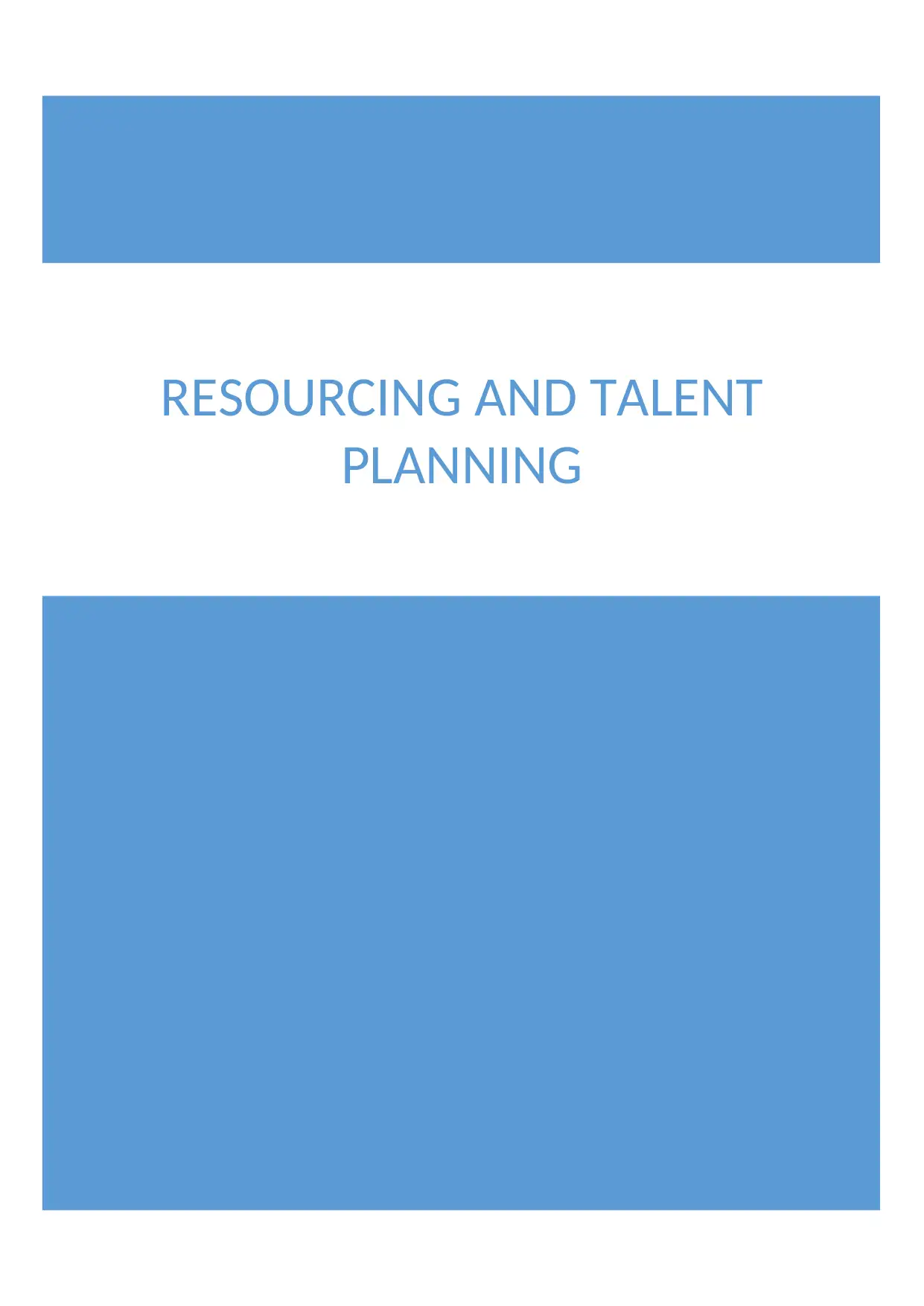
RESOURCING AND TALENT
PLANNING
PLANNING
Paraphrase This Document
Need a fresh take? Get an instant paraphrase of this document with our AI Paraphraser
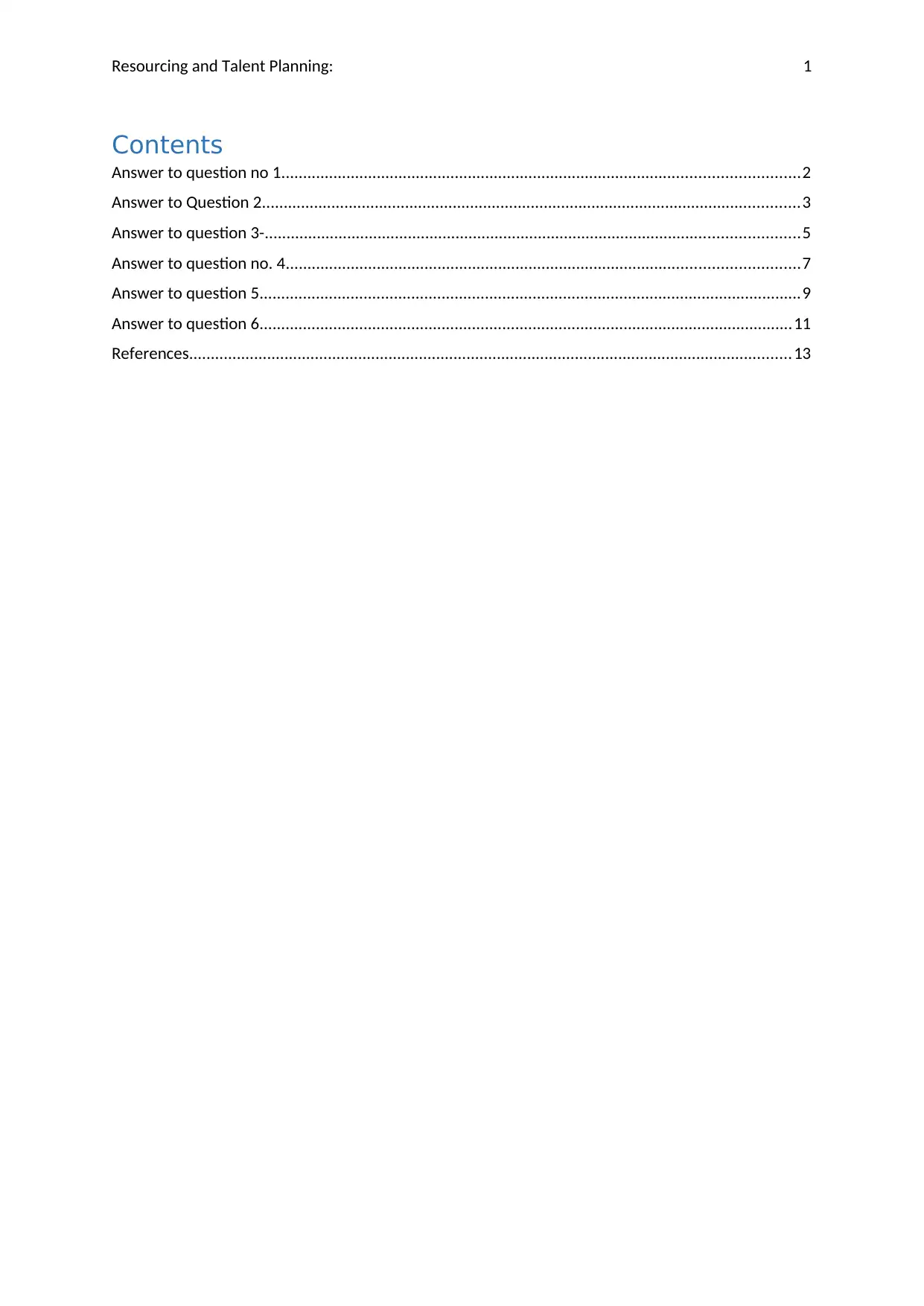
Resourcing and Talent Planning: 1
Contents
Answer to question no 1.......................................................................................................................2
Answer to Question 2............................................................................................................................3
Answer to question 3-...........................................................................................................................5
Answer to question no. 4......................................................................................................................7
Answer to question 5.............................................................................................................................9
Answer to question 6...........................................................................................................................11
References...........................................................................................................................................13
Contents
Answer to question no 1.......................................................................................................................2
Answer to Question 2............................................................................................................................3
Answer to question 3-...........................................................................................................................5
Answer to question no. 4......................................................................................................................7
Answer to question 5.............................................................................................................................9
Answer to question 6...........................................................................................................................11
References...........................................................................................................................................13
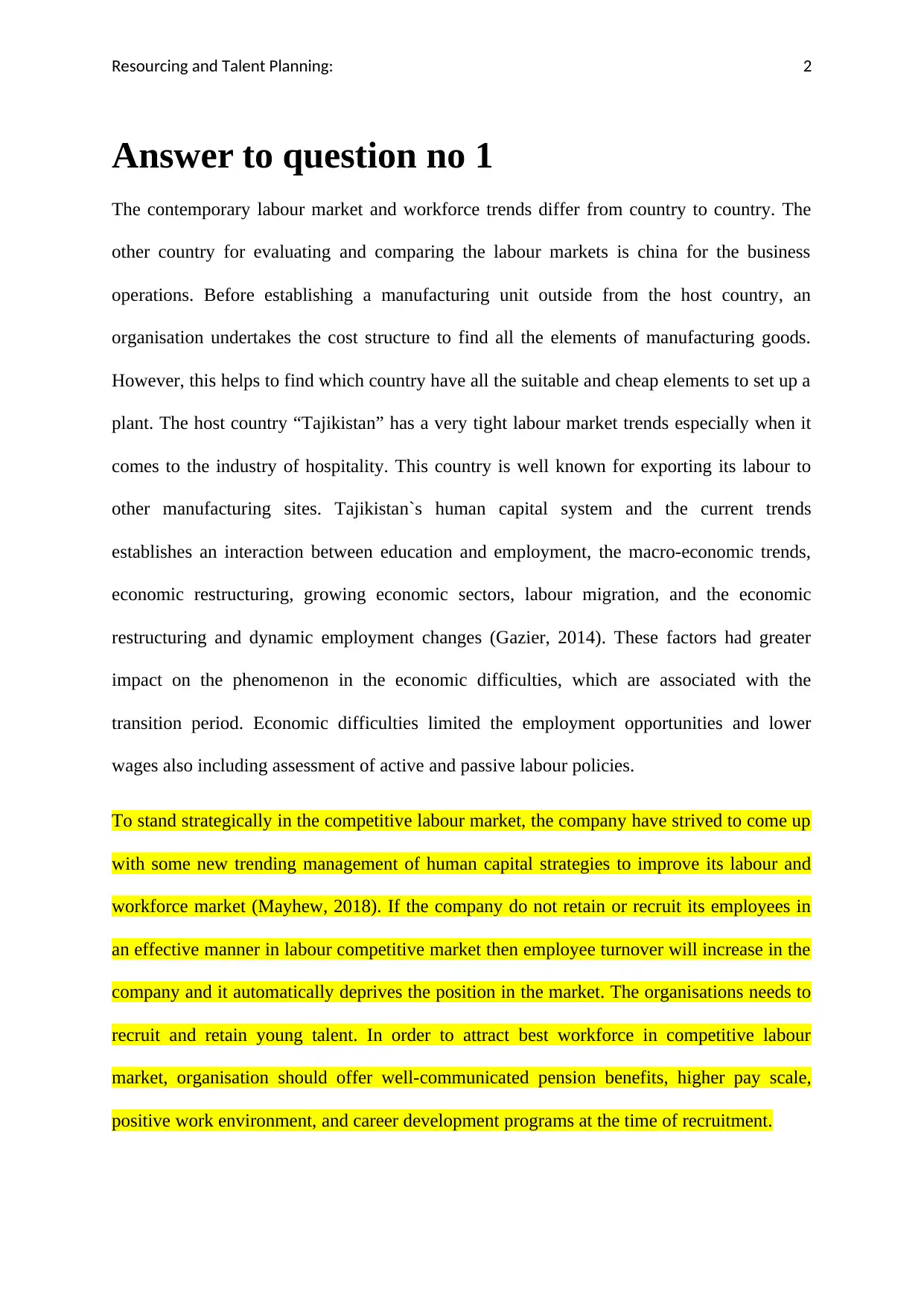
Resourcing and Talent Planning: 2
Answer to question no 1
The contemporary labour market and workforce trends differ from country to country. The
other country for evaluating and comparing the labour markets is china for the business
operations. Before establishing a manufacturing unit outside from the host country, an
organisation undertakes the cost structure to find all the elements of manufacturing goods.
However, this helps to find which country have all the suitable and cheap elements to set up a
plant. The host country “Tajikistan” has a very tight labour market trends especially when it
comes to the industry of hospitality. This country is well known for exporting its labour to
other manufacturing sites. Tajikistan`s human capital system and the current trends
establishes an interaction between education and employment, the macro-economic trends,
economic restructuring, growing economic sectors, labour migration, and the economic
restructuring and dynamic employment changes (Gazier, 2014). These factors had greater
impact on the phenomenon in the economic difficulties, which are associated with the
transition period. Economic difficulties limited the employment opportunities and lower
wages also including assessment of active and passive labour policies.
To stand strategically in the competitive labour market, the company have strived to come up
with some new trending management of human capital strategies to improve its labour and
workforce market (Mayhew, 2018). If the company do not retain or recruit its employees in
an effective manner in labour competitive market then employee turnover will increase in the
company and it automatically deprives the position in the market. The organisations needs to
recruit and retain young talent. In order to attract best workforce in competitive labour
market, organisation should offer well-communicated pension benefits, higher pay scale,
positive work environment, and career development programs at the time of recruitment.
Answer to question no 1
The contemporary labour market and workforce trends differ from country to country. The
other country for evaluating and comparing the labour markets is china for the business
operations. Before establishing a manufacturing unit outside from the host country, an
organisation undertakes the cost structure to find all the elements of manufacturing goods.
However, this helps to find which country have all the suitable and cheap elements to set up a
plant. The host country “Tajikistan” has a very tight labour market trends especially when it
comes to the industry of hospitality. This country is well known for exporting its labour to
other manufacturing sites. Tajikistan`s human capital system and the current trends
establishes an interaction between education and employment, the macro-economic trends,
economic restructuring, growing economic sectors, labour migration, and the economic
restructuring and dynamic employment changes (Gazier, 2014). These factors had greater
impact on the phenomenon in the economic difficulties, which are associated with the
transition period. Economic difficulties limited the employment opportunities and lower
wages also including assessment of active and passive labour policies.
To stand strategically in the competitive labour market, the company have strived to come up
with some new trending management of human capital strategies to improve its labour and
workforce market (Mayhew, 2018). If the company do not retain or recruit its employees in
an effective manner in labour competitive market then employee turnover will increase in the
company and it automatically deprives the position in the market. The organisations needs to
recruit and retain young talent. In order to attract best workforce in competitive labour
market, organisation should offer well-communicated pension benefits, higher pay scale,
positive work environment, and career development programs at the time of recruitment.
⊘ This is a preview!⊘
Do you want full access?
Subscribe today to unlock all pages.

Trusted by 1+ million students worldwide
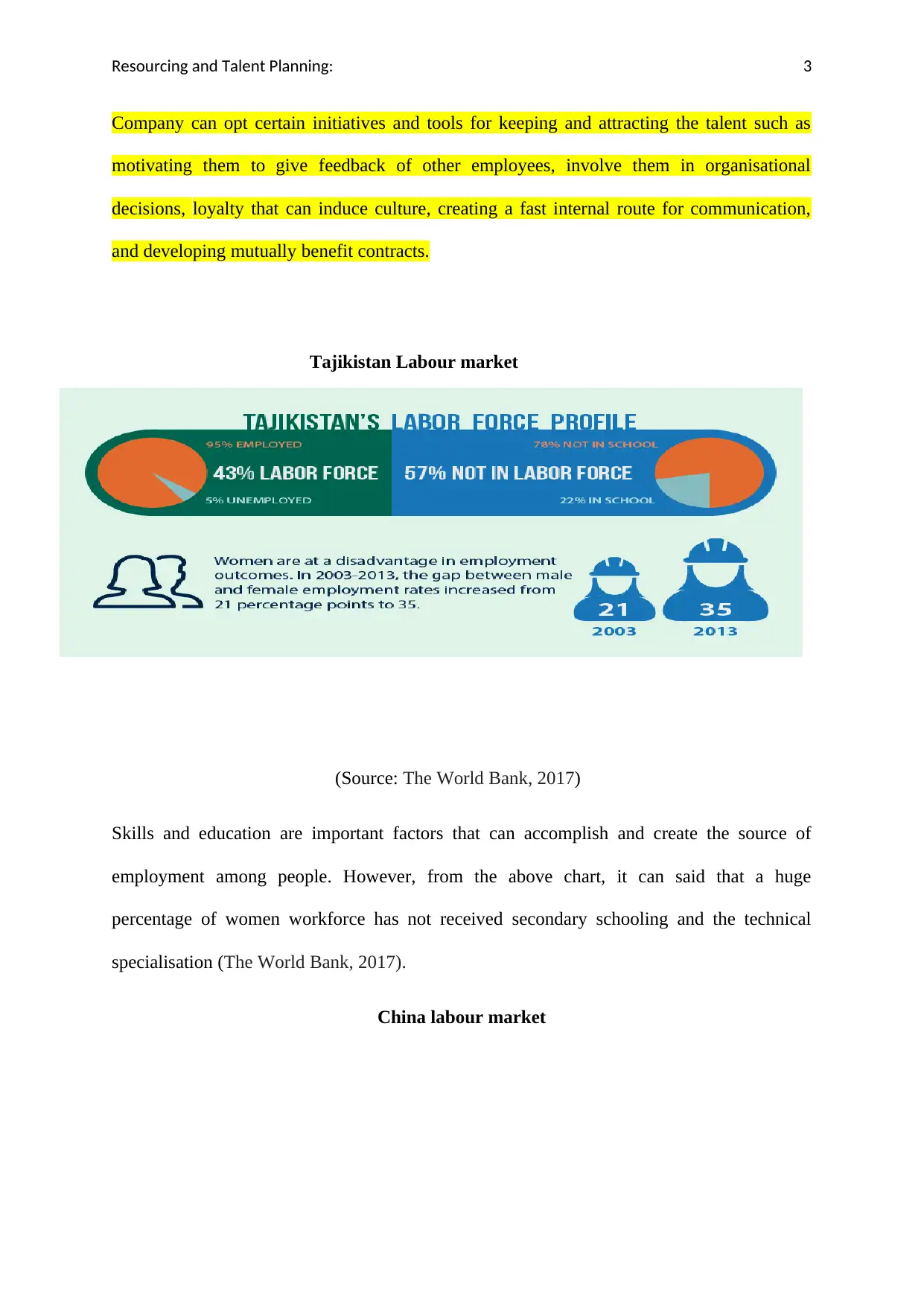
Resourcing and Talent Planning: 3
Company can opt certain initiatives and tools for keeping and attracting the talent such as
motivating them to give feedback of other employees, involve them in organisational
decisions, loyalty that can induce culture, creating a fast internal route for communication,
and developing mutually benefit contracts.
Tajikistan Labour market
(Source: The World Bank, 2017)
Skills and education are important factors that can accomplish and create the source of
employment among people. However, from the above chart, it can said that a huge
percentage of women workforce has not received secondary schooling and the technical
specialisation (The World Bank, 2017).
China labour market
Company can opt certain initiatives and tools for keeping and attracting the talent such as
motivating them to give feedback of other employees, involve them in organisational
decisions, loyalty that can induce culture, creating a fast internal route for communication,
and developing mutually benefit contracts.
Tajikistan Labour market
(Source: The World Bank, 2017)
Skills and education are important factors that can accomplish and create the source of
employment among people. However, from the above chart, it can said that a huge
percentage of women workforce has not received secondary schooling and the technical
specialisation (The World Bank, 2017).
China labour market
Paraphrase This Document
Need a fresh take? Get an instant paraphrase of this document with our AI Paraphraser
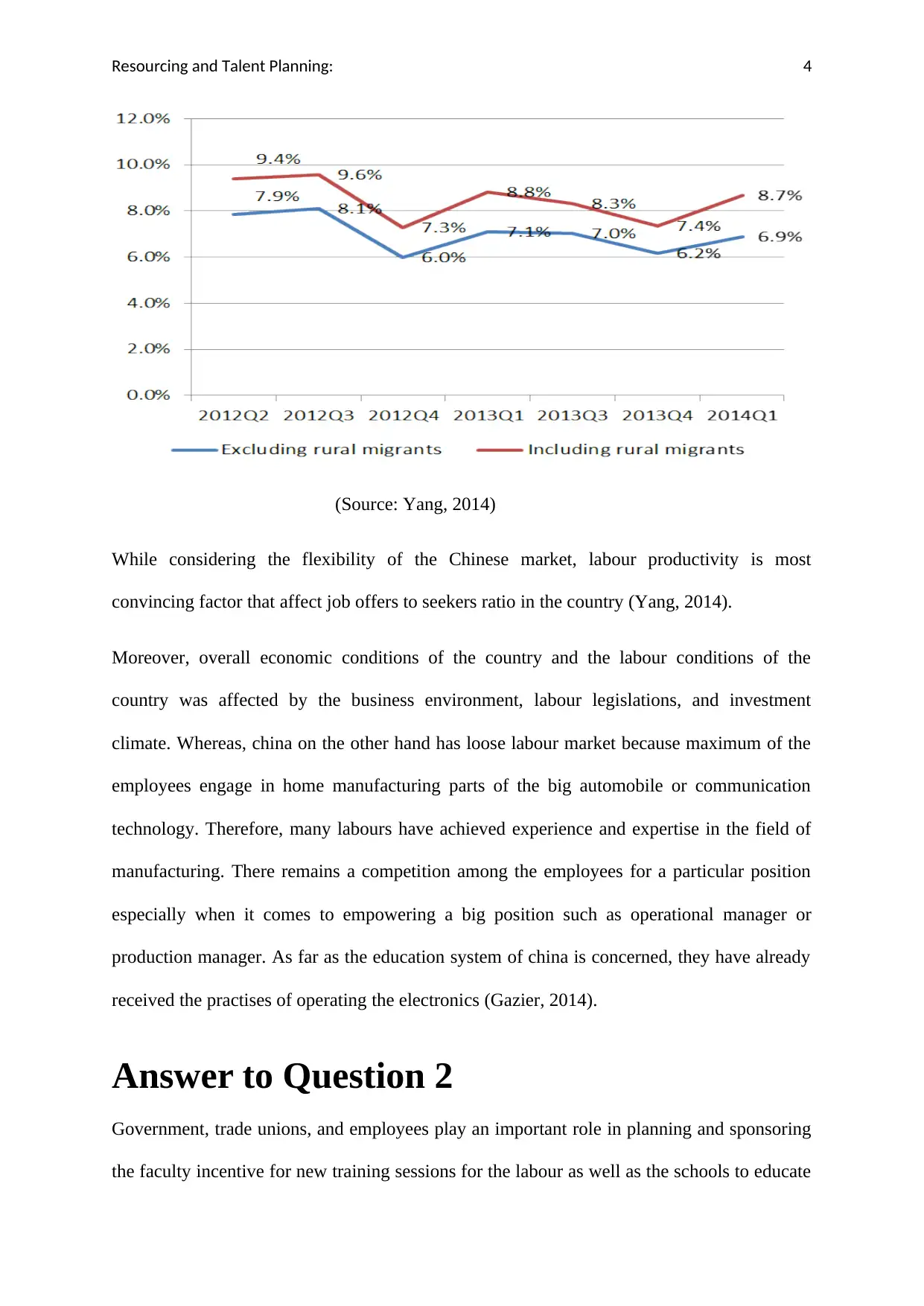
Resourcing and Talent Planning: 4
(Source: Yang, 2014)
While considering the flexibility of the Chinese market, labour productivity is most
convincing factor that affect job offers to seekers ratio in the country (Yang, 2014).
Moreover, overall economic conditions of the country and the labour conditions of the
country was affected by the business environment, labour legislations, and investment
climate. Whereas, china on the other hand has loose labour market because maximum of the
employees engage in home manufacturing parts of the big automobile or communication
technology. Therefore, many labours have achieved experience and expertise in the field of
manufacturing. There remains a competition among the employees for a particular position
especially when it comes to empowering a big position such as operational manager or
production manager. As far as the education system of china is concerned, they have already
received the practises of operating the electronics (Gazier, 2014).
Answer to Question 2
Government, trade unions, and employees play an important role in planning and sponsoring
the faculty incentive for new training sessions for the labour as well as the schools to educate
(Source: Yang, 2014)
While considering the flexibility of the Chinese market, labour productivity is most
convincing factor that affect job offers to seekers ratio in the country (Yang, 2014).
Moreover, overall economic conditions of the country and the labour conditions of the
country was affected by the business environment, labour legislations, and investment
climate. Whereas, china on the other hand has loose labour market because maximum of the
employees engage in home manufacturing parts of the big automobile or communication
technology. Therefore, many labours have achieved experience and expertise in the field of
manufacturing. There remains a competition among the employees for a particular position
especially when it comes to empowering a big position such as operational manager or
production manager. As far as the education system of china is concerned, they have already
received the practises of operating the electronics (Gazier, 2014).
Answer to Question 2
Government, trade unions, and employees play an important role in planning and sponsoring
the faculty incentive for new training sessions for the labour as well as the schools to educate
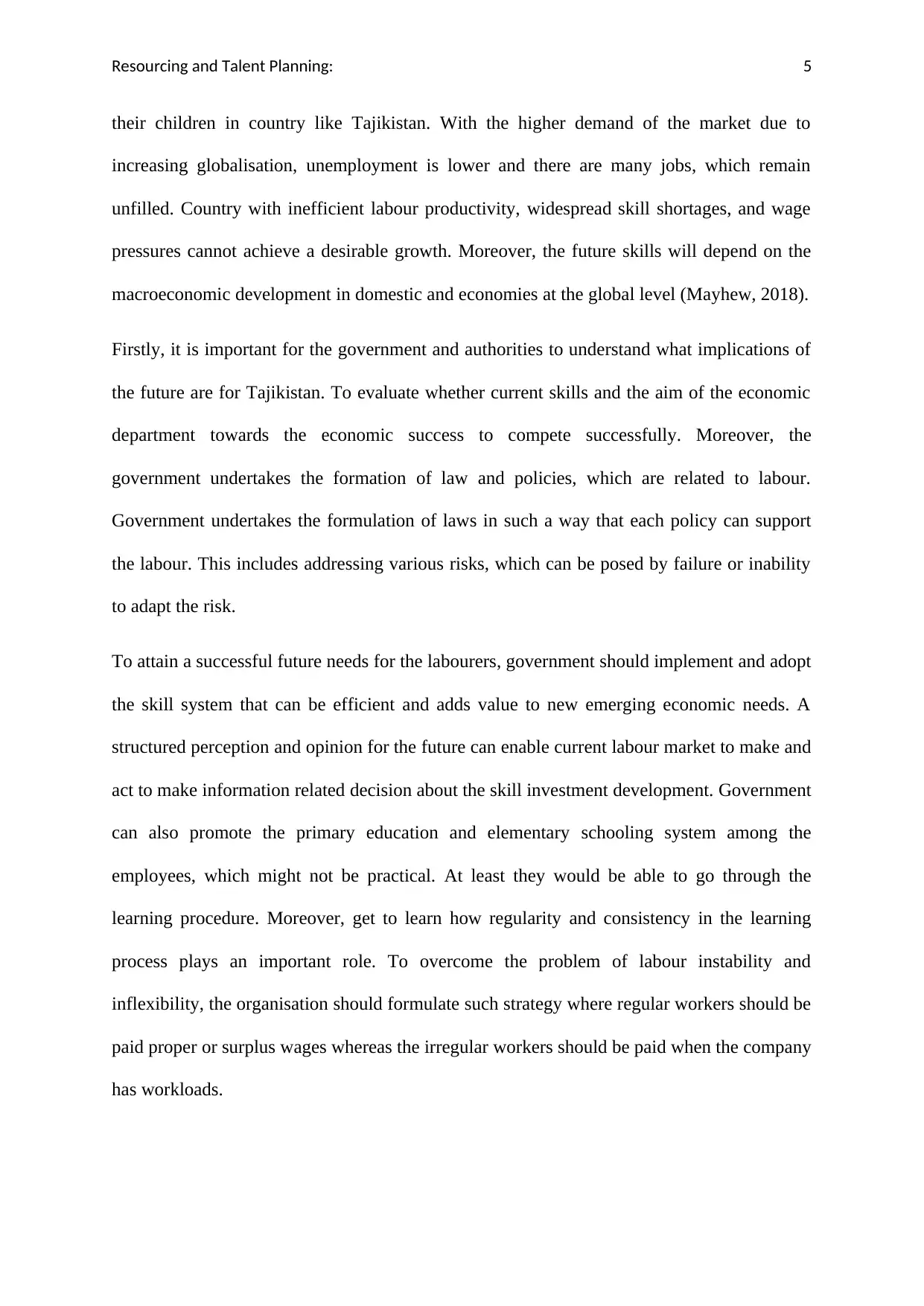
Resourcing and Talent Planning: 5
their children in country like Tajikistan. With the higher demand of the market due to
increasing globalisation, unemployment is lower and there are many jobs, which remain
unfilled. Country with inefficient labour productivity, widespread skill shortages, and wage
pressures cannot achieve a desirable growth. Moreover, the future skills will depend on the
macroeconomic development in domestic and economies at the global level (Mayhew, 2018).
Firstly, it is important for the government and authorities to understand what implications of
the future are for Tajikistan. To evaluate whether current skills and the aim of the economic
department towards the economic success to compete successfully. Moreover, the
government undertakes the formation of law and policies, which are related to labour.
Government undertakes the formulation of laws in such a way that each policy can support
the labour. This includes addressing various risks, which can be posed by failure or inability
to adapt the risk.
To attain a successful future needs for the labourers, government should implement and adopt
the skill system that can be efficient and adds value to new emerging economic needs. A
structured perception and opinion for the future can enable current labour market to make and
act to make information related decision about the skill investment development. Government
can also promote the primary education and elementary schooling system among the
employees, which might not be practical. At least they would be able to go through the
learning procedure. Moreover, get to learn how regularity and consistency in the learning
process plays an important role. To overcome the problem of labour instability and
inflexibility, the organisation should formulate such strategy where regular workers should be
paid proper or surplus wages whereas the irregular workers should be paid when the company
has workloads.
their children in country like Tajikistan. With the higher demand of the market due to
increasing globalisation, unemployment is lower and there are many jobs, which remain
unfilled. Country with inefficient labour productivity, widespread skill shortages, and wage
pressures cannot achieve a desirable growth. Moreover, the future skills will depend on the
macroeconomic development in domestic and economies at the global level (Mayhew, 2018).
Firstly, it is important for the government and authorities to understand what implications of
the future are for Tajikistan. To evaluate whether current skills and the aim of the economic
department towards the economic success to compete successfully. Moreover, the
government undertakes the formation of law and policies, which are related to labour.
Government undertakes the formulation of laws in such a way that each policy can support
the labour. This includes addressing various risks, which can be posed by failure or inability
to adapt the risk.
To attain a successful future needs for the labourers, government should implement and adopt
the skill system that can be efficient and adds value to new emerging economic needs. A
structured perception and opinion for the future can enable current labour market to make and
act to make information related decision about the skill investment development. Government
can also promote the primary education and elementary schooling system among the
employees, which might not be practical. At least they would be able to go through the
learning procedure. Moreover, get to learn how regularity and consistency in the learning
process plays an important role. To overcome the problem of labour instability and
inflexibility, the organisation should formulate such strategy where regular workers should be
paid proper or surplus wages whereas the irregular workers should be paid when the company
has workloads.
⊘ This is a preview!⊘
Do you want full access?
Subscribe today to unlock all pages.

Trusted by 1+ million students worldwide
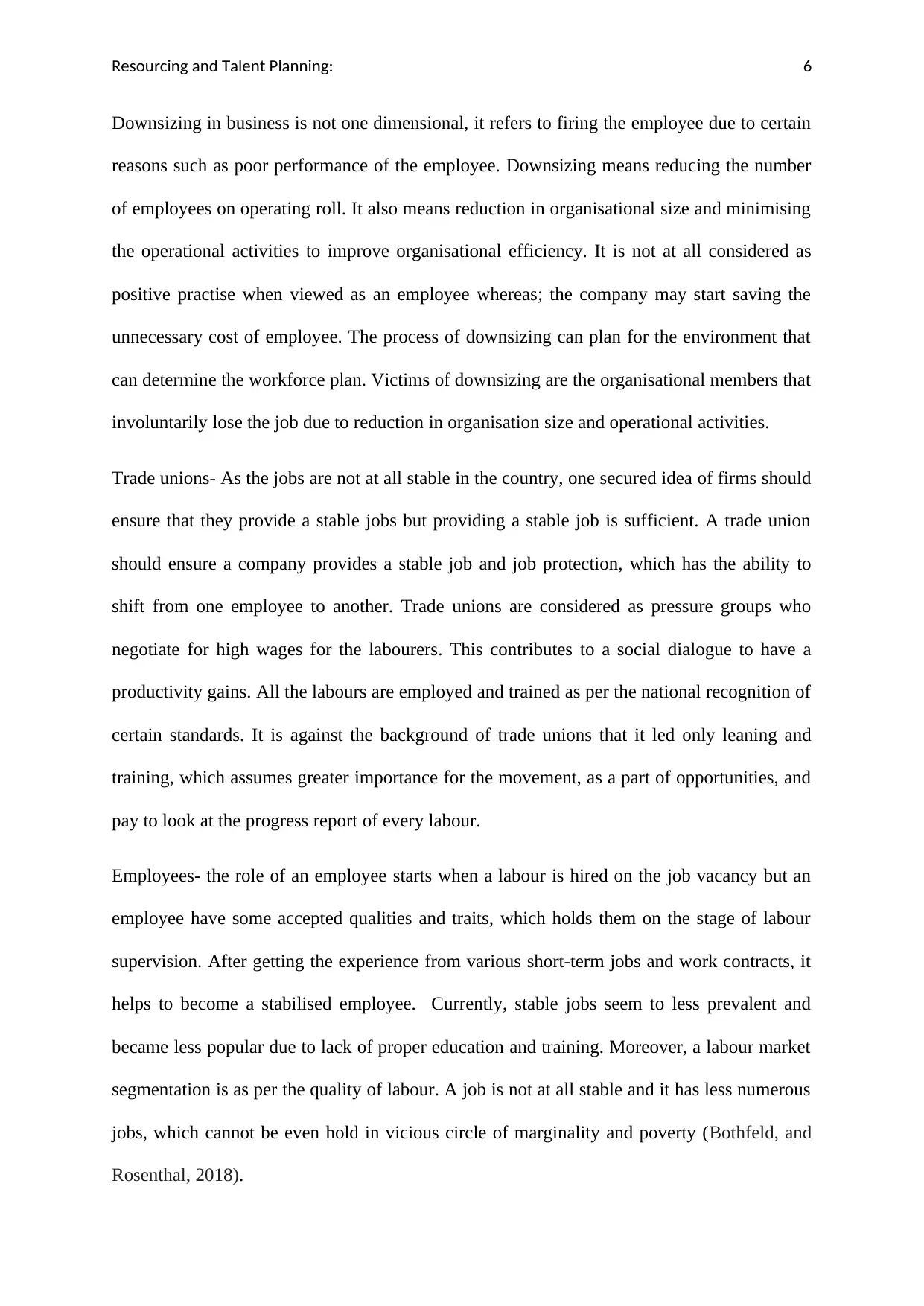
Resourcing and Talent Planning: 6
Downsizing in business is not one dimensional, it refers to firing the employee due to certain
reasons such as poor performance of the employee. Downsizing means reducing the number
of employees on operating roll. It also means reduction in organisational size and minimising
the operational activities to improve organisational efficiency. It is not at all considered as
positive practise when viewed as an employee whereas; the company may start saving the
unnecessary cost of employee. The process of downsizing can plan for the environment that
can determine the workforce plan. Victims of downsizing are the organisational members that
involuntarily lose the job due to reduction in organisation size and operational activities.
Trade unions- As the jobs are not at all stable in the country, one secured idea of firms should
ensure that they provide a stable jobs but providing a stable job is sufficient. A trade union
should ensure a company provides a stable job and job protection, which has the ability to
shift from one employee to another. Trade unions are considered as pressure groups who
negotiate for high wages for the labourers. This contributes to a social dialogue to have a
productivity gains. All the labours are employed and trained as per the national recognition of
certain standards. It is against the background of trade unions that it led only leaning and
training, which assumes greater importance for the movement, as a part of opportunities, and
pay to look at the progress report of every labour.
Employees- the role of an employee starts when a labour is hired on the job vacancy but an
employee have some accepted qualities and traits, which holds them on the stage of labour
supervision. After getting the experience from various short-term jobs and work contracts, it
helps to become a stabilised employee. Currently, stable jobs seem to less prevalent and
became less popular due to lack of proper education and training. Moreover, a labour market
segmentation is as per the quality of labour. A job is not at all stable and it has less numerous
jobs, which cannot be even hold in vicious circle of marginality and poverty (Bothfeld, and
Rosenthal, 2018).
Downsizing in business is not one dimensional, it refers to firing the employee due to certain
reasons such as poor performance of the employee. Downsizing means reducing the number
of employees on operating roll. It also means reduction in organisational size and minimising
the operational activities to improve organisational efficiency. It is not at all considered as
positive practise when viewed as an employee whereas; the company may start saving the
unnecessary cost of employee. The process of downsizing can plan for the environment that
can determine the workforce plan. Victims of downsizing are the organisational members that
involuntarily lose the job due to reduction in organisation size and operational activities.
Trade unions- As the jobs are not at all stable in the country, one secured idea of firms should
ensure that they provide a stable jobs but providing a stable job is sufficient. A trade union
should ensure a company provides a stable job and job protection, which has the ability to
shift from one employee to another. Trade unions are considered as pressure groups who
negotiate for high wages for the labourers. This contributes to a social dialogue to have a
productivity gains. All the labours are employed and trained as per the national recognition of
certain standards. It is against the background of trade unions that it led only leaning and
training, which assumes greater importance for the movement, as a part of opportunities, and
pay to look at the progress report of every labour.
Employees- the role of an employee starts when a labour is hired on the job vacancy but an
employee have some accepted qualities and traits, which holds them on the stage of labour
supervision. After getting the experience from various short-term jobs and work contracts, it
helps to become a stabilised employee. Currently, stable jobs seem to less prevalent and
became less popular due to lack of proper education and training. Moreover, a labour market
segmentation is as per the quality of labour. A job is not at all stable and it has less numerous
jobs, which cannot be even hold in vicious circle of marginality and poverty (Bothfeld, and
Rosenthal, 2018).
Paraphrase This Document
Need a fresh take? Get an instant paraphrase of this document with our AI Paraphraser
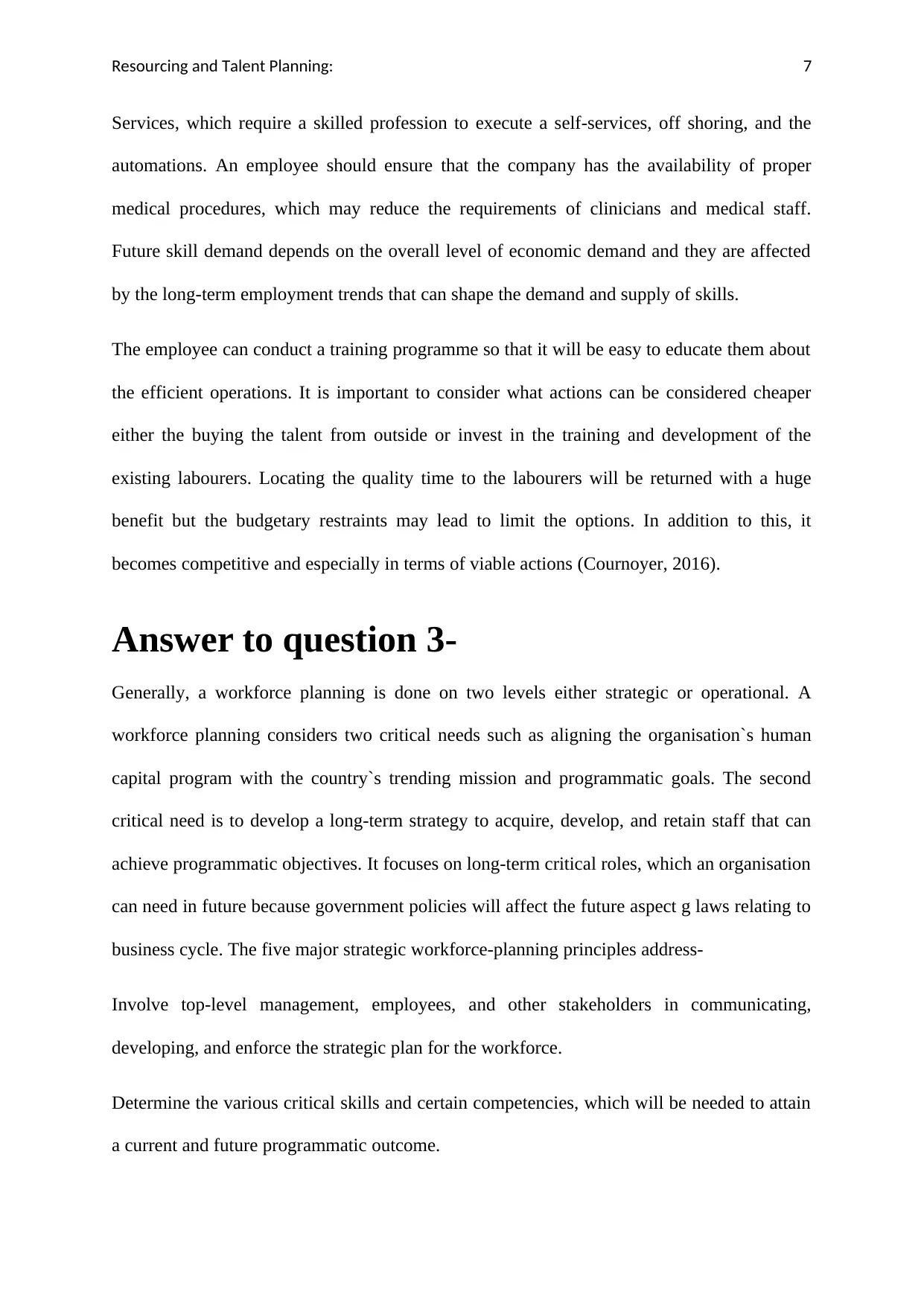
Resourcing and Talent Planning: 7
Services, which require a skilled profession to execute a self-services, off shoring, and the
automations. An employee should ensure that the company has the availability of proper
medical procedures, which may reduce the requirements of clinicians and medical staff.
Future skill demand depends on the overall level of economic demand and they are affected
by the long-term employment trends that can shape the demand and supply of skills.
The employee can conduct a training programme so that it will be easy to educate them about
the efficient operations. It is important to consider what actions can be considered cheaper
either the buying the talent from outside or invest in the training and development of the
existing labourers. Locating the quality time to the labourers will be returned with a huge
benefit but the budgetary restraints may lead to limit the options. In addition to this, it
becomes competitive and especially in terms of viable actions (Cournoyer, 2016).
Answer to question 3-
Generally, a workforce planning is done on two levels either strategic or operational. A
workforce planning considers two critical needs such as aligning the organisation`s human
capital program with the country`s trending mission and programmatic goals. The second
critical need is to develop a long-term strategy to acquire, develop, and retain staff that can
achieve programmatic objectives. It focuses on long-term critical roles, which an organisation
can need in future because government policies will affect the future aspect g laws relating to
business cycle. The five major strategic workforce-planning principles address-
Involve top-level management, employees, and other stakeholders in communicating,
developing, and enforce the strategic plan for the workforce.
Determine the various critical skills and certain competencies, which will be needed to attain
a current and future programmatic outcome.
Services, which require a skilled profession to execute a self-services, off shoring, and the
automations. An employee should ensure that the company has the availability of proper
medical procedures, which may reduce the requirements of clinicians and medical staff.
Future skill demand depends on the overall level of economic demand and they are affected
by the long-term employment trends that can shape the demand and supply of skills.
The employee can conduct a training programme so that it will be easy to educate them about
the efficient operations. It is important to consider what actions can be considered cheaper
either the buying the talent from outside or invest in the training and development of the
existing labourers. Locating the quality time to the labourers will be returned with a huge
benefit but the budgetary restraints may lead to limit the options. In addition to this, it
becomes competitive and especially in terms of viable actions (Cournoyer, 2016).
Answer to question 3-
Generally, a workforce planning is done on two levels either strategic or operational. A
workforce planning considers two critical needs such as aligning the organisation`s human
capital program with the country`s trending mission and programmatic goals. The second
critical need is to develop a long-term strategy to acquire, develop, and retain staff that can
achieve programmatic objectives. It focuses on long-term critical roles, which an organisation
can need in future because government policies will affect the future aspect g laws relating to
business cycle. The five major strategic workforce-planning principles address-
Involve top-level management, employees, and other stakeholders in communicating,
developing, and enforce the strategic plan for the workforce.
Determine the various critical skills and certain competencies, which will be needed to attain
a current and future programmatic outcome.
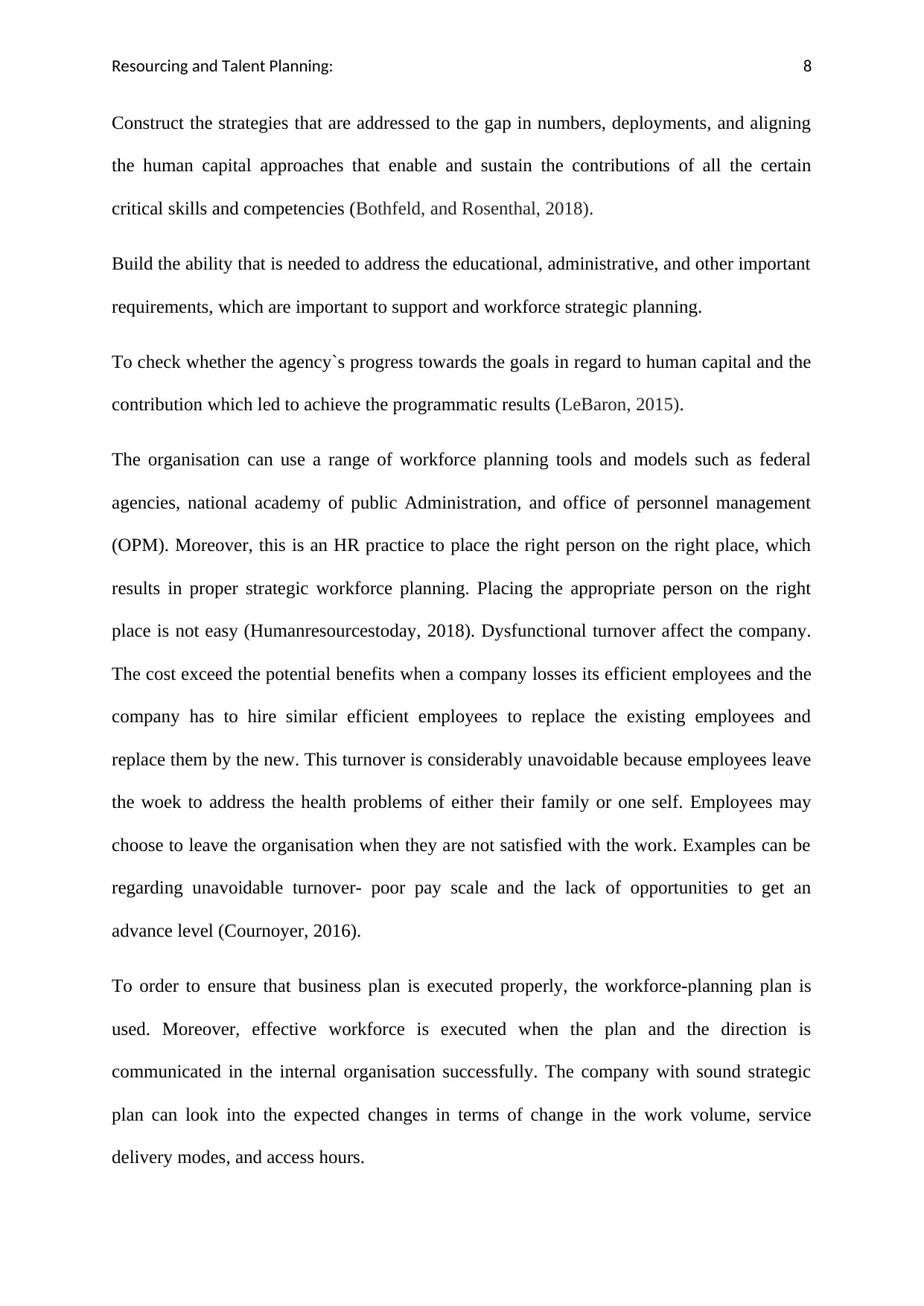
Resourcing and Talent Planning: 8
Construct the strategies that are addressed to the gap in numbers, deployments, and aligning
the human capital approaches that enable and sustain the contributions of all the certain
critical skills and competencies (Bothfeld, and Rosenthal, 2018).
Build the ability that is needed to address the educational, administrative, and other important
requirements, which are important to support and workforce strategic planning.
To check whether the agency`s progress towards the goals in regard to human capital and the
contribution which led to achieve the programmatic results (LeBaron, 2015).
The organisation can use a range of workforce planning tools and models such as federal
agencies, national academy of public Administration, and office of personnel management
(OPM). Moreover, this is an HR practice to place the right person on the right place, which
results in proper strategic workforce planning. Placing the appropriate person on the right
place is not easy (Humanresourcestoday, 2018). Dysfunctional turnover affect the company.
The cost exceed the potential benefits when a company losses its efficient employees and the
company has to hire similar efficient employees to replace the existing employees and
replace them by the new. This turnover is considerably unavoidable because employees leave
the woek to address the health problems of either their family or one self. Employees may
choose to leave the organisation when they are not satisfied with the work. Examples can be
regarding unavoidable turnover- poor pay scale and the lack of opportunities to get an
advance level (Cournoyer, 2016).
To order to ensure that business plan is executed properly, the workforce-planning plan is
used. Moreover, effective workforce is executed when the plan and the direction is
communicated in the internal organisation successfully. The company with sound strategic
plan can look into the expected changes in terms of change in the work volume, service
delivery modes, and access hours.
Construct the strategies that are addressed to the gap in numbers, deployments, and aligning
the human capital approaches that enable and sustain the contributions of all the certain
critical skills and competencies (Bothfeld, and Rosenthal, 2018).
Build the ability that is needed to address the educational, administrative, and other important
requirements, which are important to support and workforce strategic planning.
To check whether the agency`s progress towards the goals in regard to human capital and the
contribution which led to achieve the programmatic results (LeBaron, 2015).
The organisation can use a range of workforce planning tools and models such as federal
agencies, national academy of public Administration, and office of personnel management
(OPM). Moreover, this is an HR practice to place the right person on the right place, which
results in proper strategic workforce planning. Placing the appropriate person on the right
place is not easy (Humanresourcestoday, 2018). Dysfunctional turnover affect the company.
The cost exceed the potential benefits when a company losses its efficient employees and the
company has to hire similar efficient employees to replace the existing employees and
replace them by the new. This turnover is considerably unavoidable because employees leave
the woek to address the health problems of either their family or one self. Employees may
choose to leave the organisation when they are not satisfied with the work. Examples can be
regarding unavoidable turnover- poor pay scale and the lack of opportunities to get an
advance level (Cournoyer, 2016).
To order to ensure that business plan is executed properly, the workforce-planning plan is
used. Moreover, effective workforce is executed when the plan and the direction is
communicated in the internal organisation successfully. The company with sound strategic
plan can look into the expected changes in terms of change in the work volume, service
delivery modes, and access hours.
⊘ This is a preview!⊘
Do you want full access?
Subscribe today to unlock all pages.

Trusted by 1+ million students worldwide
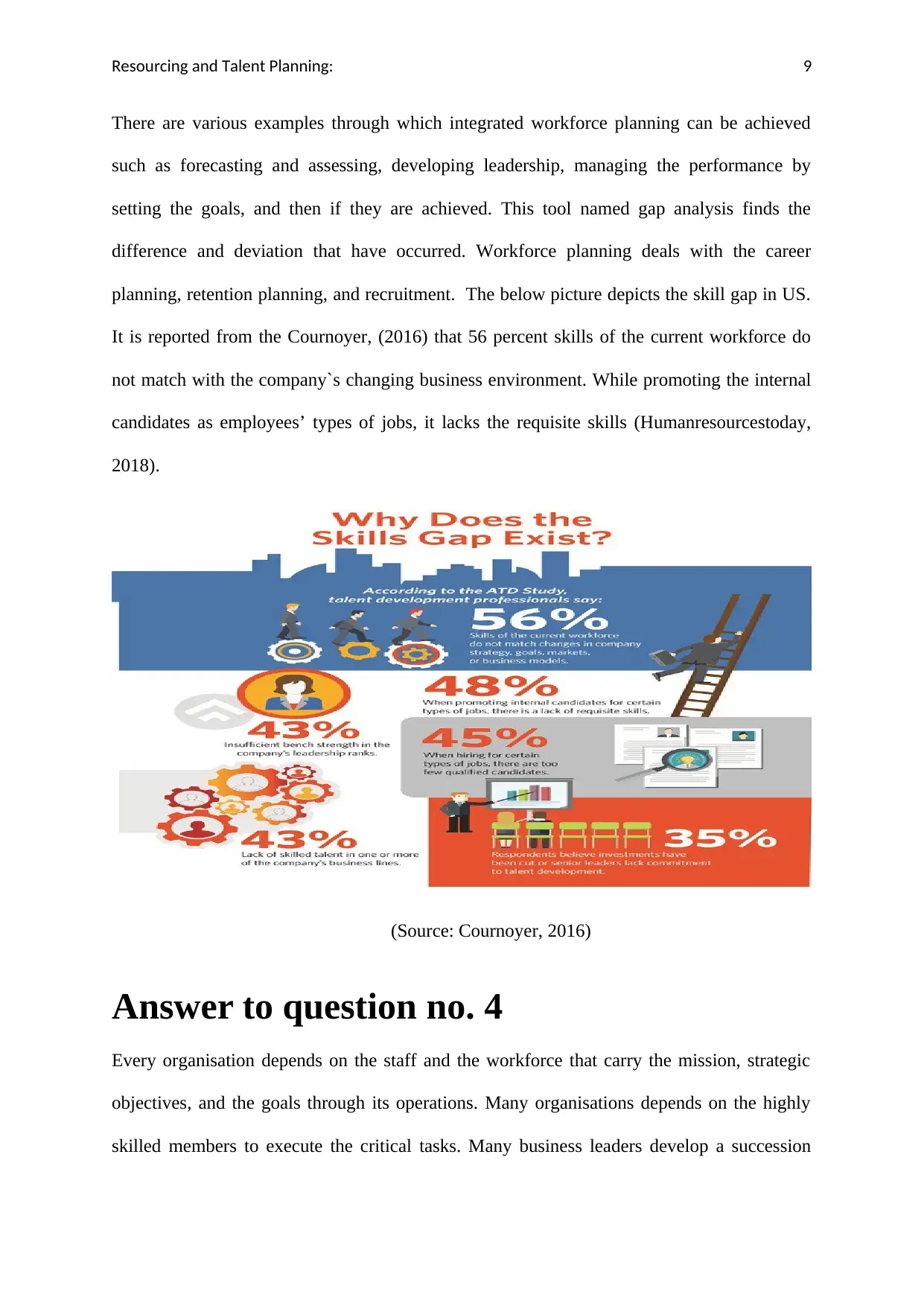
Resourcing and Talent Planning: 9
There are various examples through which integrated workforce planning can be achieved
such as forecasting and assessing, developing leadership, managing the performance by
setting the goals, and then if they are achieved. This tool named gap analysis finds the
difference and deviation that have occurred. Workforce planning deals with the career
planning, retention planning, and recruitment. The below picture depicts the skill gap in US.
It is reported from the Cournoyer, (2016) that 56 percent skills of the current workforce do
not match with the company`s changing business environment. While promoting the internal
candidates as employees’ types of jobs, it lacks the requisite skills (Humanresourcestoday,
2018).
(Source: Cournoyer, 2016)
Answer to question no. 4
Every organisation depends on the staff and the workforce that carry the mission, strategic
objectives, and the goals through its operations. Many organisations depends on the highly
skilled members to execute the critical tasks. Many business leaders develop a succession
There are various examples through which integrated workforce planning can be achieved
such as forecasting and assessing, developing leadership, managing the performance by
setting the goals, and then if they are achieved. This tool named gap analysis finds the
difference and deviation that have occurred. Workforce planning deals with the career
planning, retention planning, and recruitment. The below picture depicts the skill gap in US.
It is reported from the Cournoyer, (2016) that 56 percent skills of the current workforce do
not match with the company`s changing business environment. While promoting the internal
candidates as employees’ types of jobs, it lacks the requisite skills (Humanresourcestoday,
2018).
(Source: Cournoyer, 2016)
Answer to question no. 4
Every organisation depends on the staff and the workforce that carry the mission, strategic
objectives, and the goals through its operations. Many organisations depends on the highly
skilled members to execute the critical tasks. Many business leaders develop a succession
Paraphrase This Document
Need a fresh take? Get an instant paraphrase of this document with our AI Paraphraser
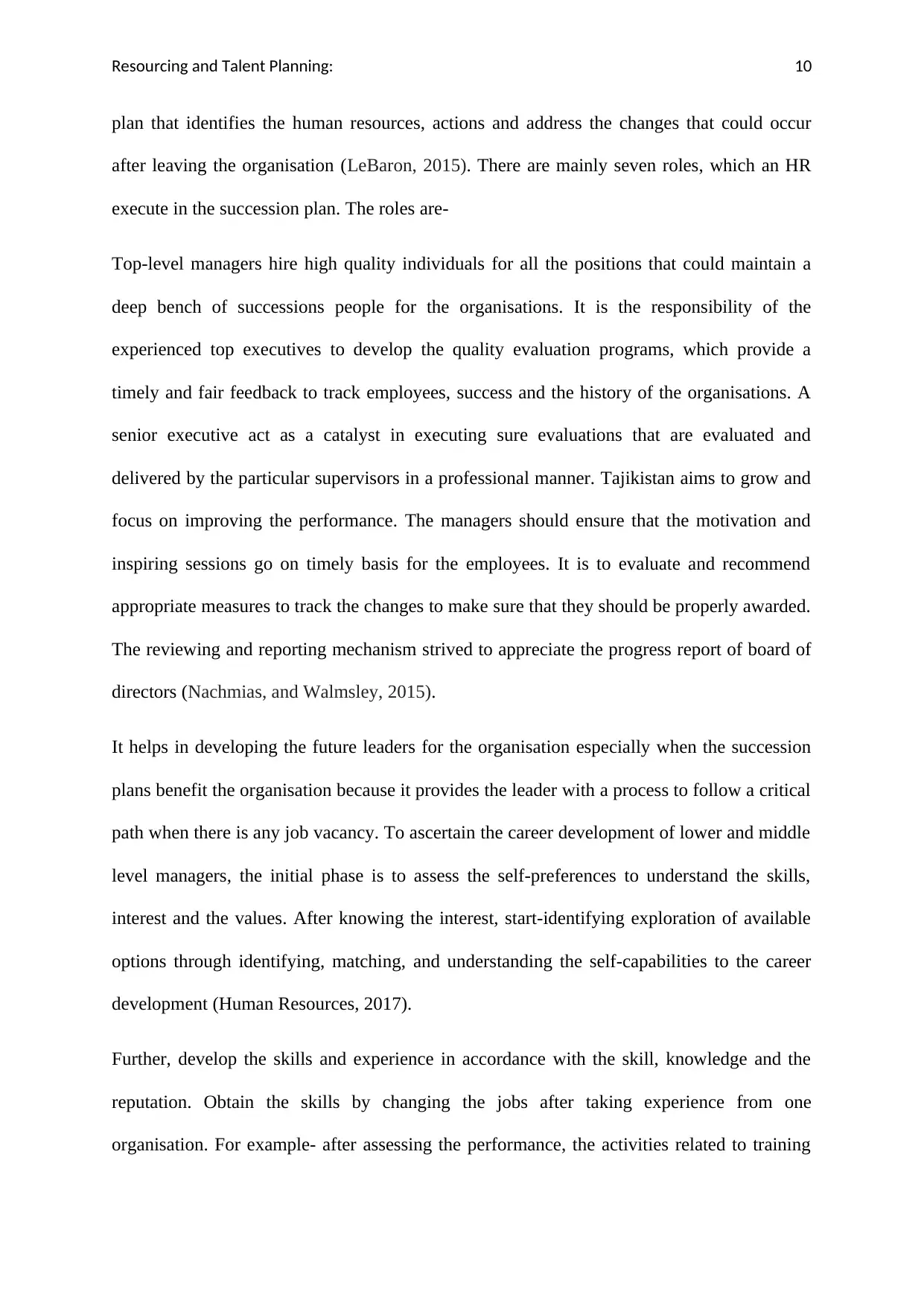
Resourcing and Talent Planning: 10
plan that identifies the human resources, actions and address the changes that could occur
after leaving the organisation (LeBaron, 2015). There are mainly seven roles, which an HR
execute in the succession plan. The roles are-
Top-level managers hire high quality individuals for all the positions that could maintain a
deep bench of successions people for the organisations. It is the responsibility of the
experienced top executives to develop the quality evaluation programs, which provide a
timely and fair feedback to track employees, success and the history of the organisations. A
senior executive act as a catalyst in executing sure evaluations that are evaluated and
delivered by the particular supervisors in a professional manner. Tajikistan aims to grow and
focus on improving the performance. The managers should ensure that the motivation and
inspiring sessions go on timely basis for the employees. It is to evaluate and recommend
appropriate measures to track the changes to make sure that they should be properly awarded.
The reviewing and reporting mechanism strived to appreciate the progress report of board of
directors (Nachmias, and Walmsley, 2015).
It helps in developing the future leaders for the organisation especially when the succession
plans benefit the organisation because it provides the leader with a process to follow a critical
path when there is any job vacancy. To ascertain the career development of lower and middle
level managers, the initial phase is to assess the self-preferences to understand the skills,
interest and the values. After knowing the interest, start-identifying exploration of available
options through identifying, matching, and understanding the self-capabilities to the career
development (Human Resources, 2017).
Further, develop the skills and experience in accordance with the skill, knowledge and the
reputation. Obtain the skills by changing the jobs after taking experience from one
organisation. For example- after assessing the performance, the activities related to training
plan that identifies the human resources, actions and address the changes that could occur
after leaving the organisation (LeBaron, 2015). There are mainly seven roles, which an HR
execute in the succession plan. The roles are-
Top-level managers hire high quality individuals for all the positions that could maintain a
deep bench of successions people for the organisations. It is the responsibility of the
experienced top executives to develop the quality evaluation programs, which provide a
timely and fair feedback to track employees, success and the history of the organisations. A
senior executive act as a catalyst in executing sure evaluations that are evaluated and
delivered by the particular supervisors in a professional manner. Tajikistan aims to grow and
focus on improving the performance. The managers should ensure that the motivation and
inspiring sessions go on timely basis for the employees. It is to evaluate and recommend
appropriate measures to track the changes to make sure that they should be properly awarded.
The reviewing and reporting mechanism strived to appreciate the progress report of board of
directors (Nachmias, and Walmsley, 2015).
It helps in developing the future leaders for the organisation especially when the succession
plans benefit the organisation because it provides the leader with a process to follow a critical
path when there is any job vacancy. To ascertain the career development of lower and middle
level managers, the initial phase is to assess the self-preferences to understand the skills,
interest and the values. After knowing the interest, start-identifying exploration of available
options through identifying, matching, and understanding the self-capabilities to the career
development (Human Resources, 2017).
Further, develop the skills and experience in accordance with the skill, knowledge and the
reputation. Obtain the skills by changing the jobs after taking experience from one
organisation. For example- after assessing the performance, the activities related to training
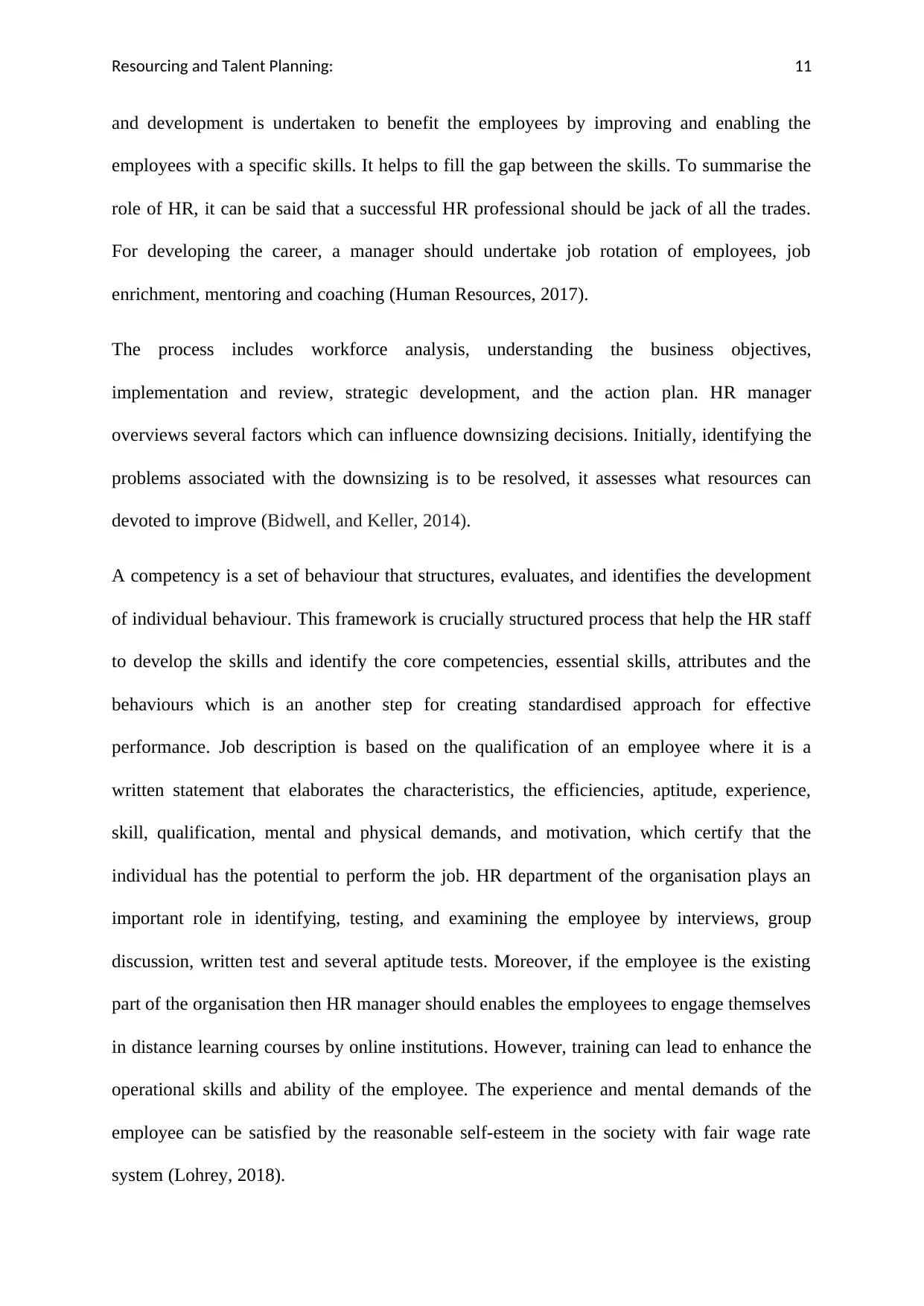
Resourcing and Talent Planning: 11
and development is undertaken to benefit the employees by improving and enabling the
employees with a specific skills. It helps to fill the gap between the skills. To summarise the
role of HR, it can be said that a successful HR professional should be jack of all the trades.
For developing the career, a manager should undertake job rotation of employees, job
enrichment, mentoring and coaching (Human Resources, 2017).
The process includes workforce analysis, understanding the business objectives,
implementation and review, strategic development, and the action plan. HR manager
overviews several factors which can influence downsizing decisions. Initially, identifying the
problems associated with the downsizing is to be resolved, it assesses what resources can
devoted to improve (Bidwell, and Keller, 2014).
A competency is a set of behaviour that structures, evaluates, and identifies the development
of individual behaviour. This framework is crucially structured process that help the HR staff
to develop the skills and identify the core competencies, essential skills, attributes and the
behaviours which is an another step for creating standardised approach for effective
performance. Job description is based on the qualification of an employee where it is a
written statement that elaborates the characteristics, the efficiencies, aptitude, experience,
skill, qualification, mental and physical demands, and motivation, which certify that the
individual has the potential to perform the job. HR department of the organisation plays an
important role in identifying, testing, and examining the employee by interviews, group
discussion, written test and several aptitude tests. Moreover, if the employee is the existing
part of the organisation then HR manager should enables the employees to engage themselves
in distance learning courses by online institutions. However, training can lead to enhance the
operational skills and ability of the employee. The experience and mental demands of the
employee can be satisfied by the reasonable self-esteem in the society with fair wage rate
system (Lohrey, 2018).
and development is undertaken to benefit the employees by improving and enabling the
employees with a specific skills. It helps to fill the gap between the skills. To summarise the
role of HR, it can be said that a successful HR professional should be jack of all the trades.
For developing the career, a manager should undertake job rotation of employees, job
enrichment, mentoring and coaching (Human Resources, 2017).
The process includes workforce analysis, understanding the business objectives,
implementation and review, strategic development, and the action plan. HR manager
overviews several factors which can influence downsizing decisions. Initially, identifying the
problems associated with the downsizing is to be resolved, it assesses what resources can
devoted to improve (Bidwell, and Keller, 2014).
A competency is a set of behaviour that structures, evaluates, and identifies the development
of individual behaviour. This framework is crucially structured process that help the HR staff
to develop the skills and identify the core competencies, essential skills, attributes and the
behaviours which is an another step for creating standardised approach for effective
performance. Job description is based on the qualification of an employee where it is a
written statement that elaborates the characteristics, the efficiencies, aptitude, experience,
skill, qualification, mental and physical demands, and motivation, which certify that the
individual has the potential to perform the job. HR department of the organisation plays an
important role in identifying, testing, and examining the employee by interviews, group
discussion, written test and several aptitude tests. Moreover, if the employee is the existing
part of the organisation then HR manager should enables the employees to engage themselves
in distance learning courses by online institutions. However, training can lead to enhance the
operational skills and ability of the employee. The experience and mental demands of the
employee can be satisfied by the reasonable self-esteem in the society with fair wage rate
system (Lohrey, 2018).
⊘ This is a preview!⊘
Do you want full access?
Subscribe today to unlock all pages.

Trusted by 1+ million students worldwide
1 out of 19
Related Documents
Your All-in-One AI-Powered Toolkit for Academic Success.
+13062052269
info@desklib.com
Available 24*7 on WhatsApp / Email
![[object Object]](/_next/static/media/star-bottom.7253800d.svg)
Unlock your academic potential
Copyright © 2020–2025 A2Z Services. All Rights Reserved. Developed and managed by ZUCOL.





